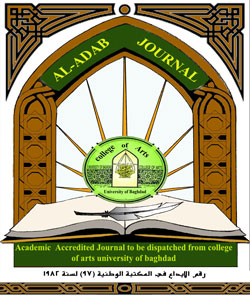The Impact of Developing the EFL University Students' Awareness in the Use of Pragmatic Markers on their Essay Writing ability
DOI:
https://doi.org/10.31973/aj.v0i133.870الكلمات المفتاحية:
Writing، EFL، Studentsالملخص
ان عملية الكتابة لا تتضمن فقط كتابة نص جيد, وانما تتضمن ايضا اهمية وجود تماسك وتناسق للنص المكتوب. فأن أنشاء نص مكون من مجموعة من الجمل بدون أخذ الروابط التماسكية بعين الاعتبار, يؤدي الى الفشل في ايصال الرسالة المرجوة من النص المكتوب. وعليه فأن وجود العلامات النصية هو شرط اساسي في جعل النص المكتوب اكثر سلاسة. ولذلك, فان كتابة اي مقالة تتطلب الاتقان والدقة في اختيار العلامات الواقعية النصية. فهذه العلامات, في اعتقاد الكثير من الكتاب, تعد جزء مهم من كفاءة المتعلمين واستراتيجيتهم في الكتابة. ان وجود مثل هذه العلامات في نص يعمل على دعم وتقوية النص ولا يغير من معنى النص. فالعلامات الواقعية مثل: بالطبع, بالتاكيد, حسنا,...الخ.
تهدف الدراسة الحالية الى اختبار اداء المتعلمين في استخدام العلامات الواقعية. وتهدف ايضا الى التقصي عن اثر تطوير هذه العلامات عندهم على تحسين قابيليتهم في كتابة المقالة. وسيجيب البحث ايضا عن الاسئلة الآتية: كيف هو اداء المتعلمين في كتابة المقالة؟ ماهو الفرق بين المجموعة الضابطة والمجموعة التجريبية؟ هل هنالك علاقة ذات اهمية بين تطوير قابلية المتعلمين باستخدام العلامات الواقعية وبين تحسن قابليتهم في كتابة المقالة.
التنزيلات
المراجع
John Benjamins.
Aijmer, K. (2013). Understanding Pragmatic Markers: a Variational Pragmatic Approach. Edinburgh: Edinburgh University Press.
Andersen, G. (2001). Pragmatic Markers and Sociolinguistic Variation: A Relevance-Theoretic Approach to the Language of Adolescents. Amsterdam and Philadelphia: John Benjamins.
Bach, K & R. Harnish. (1979). Linguistic Communication and Speech Acts. MIT Press.
Blakemore, D. . (1987) Semantic Constraints on Relevance. Oxford: Blackwell.
Blakemore, D. (1992). Understanding Utterances: An Introduction to Pragmatics. Oxford: Blackwell.
Blakemore, D. (2008). Discourse Markers. In R. L. Horn & G. Ward (Eds.), The
handbook of pragmatics (pp. 221-240). Malden, MA: Blackwell.
Brown, P & S. Levinson (1987) Politeness. Cambridge: Cambridge University Press
Carter, R., & McCarthy, M. (2006). Cambridge grammar of English: A comprehensive guide. Cambridge: Cambridge University Press.
Feng, L. (2010). Discourse Markers in English Writing. Journal of International Social Research, Vol. 3/11, Spring 2010.
Fraser, Bruce. (1990). An approach to Discourse Markers. Journal of linguistics 14.
Fraser, Bruce. (1991). Perspectives on Politeness. Journal of Pragmatics14.
Fraser, Bruce. (1996). Pragmatic Markers. Pragmatics 6 (2): 167–190.
Fraser, B. (1999). What are Discourse Markers? Journal of Pragmatics, 31, 931-952.
Fung, L., & Carter, R. (2007). Discourse Markers and Spoken English: Native and
Learner Use in Pedagogic Settings. Applied Linguistics, 28, 410-439.
Gay, L. R. & Geoffrey E.M. (2010) Educational Research. Competencies for Analysis and Application. Columbus: Prentice Hall.
Good, Thomas L. and Colin N. Power (1976). The Effect of Teaching: an Optimistic Note. The Elementary School Journal. Vol. 76, No. 6.
Halliday, M. A. K., & Hasan, R. (1976). Cohesion in English. London: Longman.
Hellermann, J., & Vergun, A. (2007). Language Which is not Taught: The Discourse
Marker Use of Beginning Adult Learners of English. Journal of Pragmatics,
39, 157-179.
Hasselgreen, A. (2004). Testing the Spoken English of Young Norwegians: A studyof test validity and the role of "smallwords" in contributing to pupils' fluency.Cambridge: Cambridge University Press.
Kasper, G. (1992). Pragmatic Transfer. Second Language Research, 8(3), 203-231.
McCarthy, M. J., & Carter, R.A. (1995). Spoken Grammar: What is it and How Can We Teach it? English Language Teaching Journal, 49(3), 207-218.
Müller, S. (2005). Discourse markers in native and non-native English discourse.
Amsterdam: John Benjamins.
Overstreet, M., & Yule, G. (1997). Fostering Pragmatic Awareness. Applied Language
Learning, 10(1), 1-14.
Romero-Trillo, J. (2002). The pragmatic Fossilization of Discourse Markers in
non- Native Speakers of English. Journal of Pragmatics, 34, 769-784.
Romero-Trillo, J. (2012). Pragmatic Markers. The encyclopedia of applied linguistics.
Schiffrin, D. (1987). Discourse markers. Cambridge: Cambridge University Press.
Schmidt, R. (1990). The Role of Consciousness in Second Language Learning. Applied Linguistics, 11(2), 120-158.
Schourup, L. (1999). Discourse Markers. Lingua, 107(3-4), 227-265.
Skehan, P. (1998). A Cognitive Approach to Language Learning. Oxford: Oxford University Press.
Sperber, D., & Wilson, D. (1995). Relevance: Communication and Cognition. Oxford: Blackwell.
Towell, R., Hawkins, R., & Bazergui, N. (1996). The Development of Fluency in Advanced Learners of French. Applied linguistics, 17, 84-119.
VanPattern, B. (1996). Input Processing and Grammar Instruction: Theory and Research. Norwood, NJ: Ablex.
التنزيلات
منشور
إصدار
القسم
الرخصة
:حقوق الطبع والنشر والترخيص
بالنسبة لجميع البحوث المنشورة في مجلة الآداب، يحتفظ الباحثون بحقوق النشر. يتم ترخيص البحوث بموجب ترخيص Creative Commons CC BY 4.0 المفتوح ، مما يعني أنه يجوز لأي شخص تنزيل البحث وقراءته مجانًا. بالإضافة إلى ذلك ، يجوز إعادة استخدام البحث واقتباسه شريطة أن يتم الاستشهاد المصدر المنشور الأصلي. تتيح هذه الشروط الاستخدام الأقصى لعمل الباحث وعرضه.
:إعادة إنتاج البحوث المنشورة من الناشرين الآخرين
من الضروري للغاية أن يحصل الباحثون على إذن لإعادة إنتاج أي بحث منشورة (أشكال أو مخططات أو جداول أو أي مقتطفات من نص) لا يدخل في نطاق الملكية العامة أو لا يملكون حقوق نشرها. يجب أن يطلب الباحثون إذنًا من مؤلف حقوق النشر (عادة ما يكون الناشر).
يطلب الإذن في الحالات التالية:
بحوثك الخاصة المنشورة من قِبل ناشرين آخرين ولم تحتفظ بحقوق النشر الخاصة بها.
مقتطفات كبيرة من بحوث أي شخص أو سلسلة من البحوث المنشورة.
استخدم الجداول والرسوم البيانية والمخططات والمخططات والأعمال الفنية إذا لم يتم التعديل عليها.
الصور الفوتوغرافية التي لا تملك حقوق لنشرها.
لا يطلب الإذن في الحالات التالية:
إعادة بناء الجدول الخاص بك مع البيانات المنشورة بالفعل في مكان آخر. يرجى ملاحظة أنه في هذه الحالة يجب عليك ذكر مصدر البيانات في شكل "بيانات من ..." أو "مقتبس من ...".
تعتبر عروض الأسعار القصيرة معقولة الاستخدام العادل ، وبالتالي لا تتطلب إذنًا.
الرسوم البيانية ، الرسوم البيانية ، المخططات ، الأعمال الفنية التي أعاد الباحث رسمها بالكامل والتي تم تغييرها بشكل ملحوظ إلى درجة لا تتطلب الاعتراف.
الحصول على إذن
لتجنب التأخير غير الضروري في عملية النشر ، يجب أن تبدأ في الحصول على أذونات في أقرب وقت ممكن. لا يمكن لمجلة الآداب نشر بحث مقتبس من منشورات أخرى دون إذن.
قد يمنحك مالك حقوق الطبع والنشر تعليمات بشأن شكل الإقرار الواجب اتباعه لتوثيق عمله ؛ بخلاف ذلك ، اتبع النمط: "مستنسخ بإذن من [المؤلف] ، [كتاب / المجلة] ؛ نشره [الناشر] ، [السنة]." في نهاية شرح الجدول ، الشكل أو المخطط.
.jpg)























